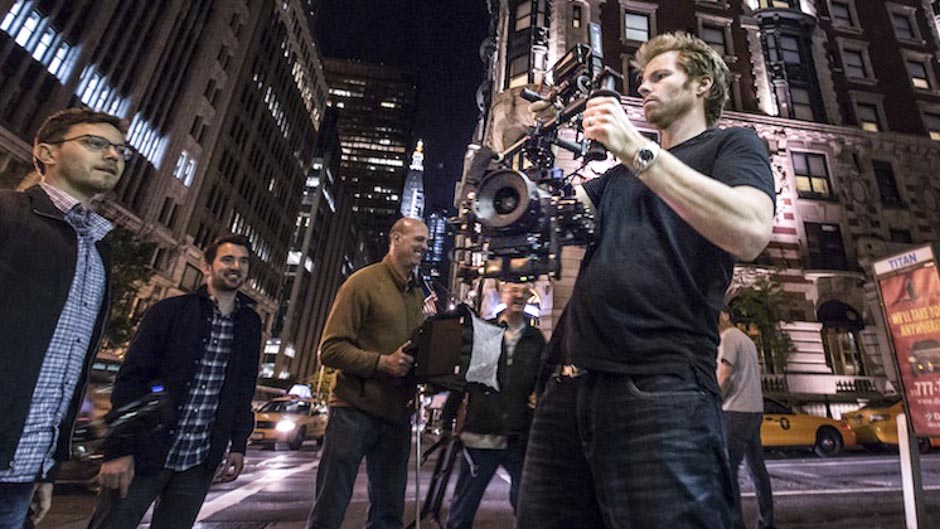I’ve been meaning to write this post about my experience using the MōVI for an SNL shoot back in May but I’ve been a little buried with the launch of my summer workshop tour. The good news is that, since we have a MōVI with us on the tour, it’s given me even more experience to share. I know there is a lot of excitement and anticipation over this rig so I thought ya’ll would like to hear an experience from the trenches of an actual shoot, as well as everything else I’ve learned by playing with this rig every day for the past month.
A little history: back in March, I got a call from my friend Monsieur Laforet: “Where are you right now? I’m in New York and I’ve just seen the most amazing new handheld rig. We’re shooting a short film with it this weekend and you gotta see this thing to believe it…” It was a dark week at SNL so I was at home in Los Angeles – my loss. Vince (along with DP Timur Civan) went on to make the MōVI demo seen ’round the world and the rest is NAB history. I watched the Vimeo clip with the rest of you guys, mouth agape, trying to make sense of what I was looking at. That roller-blading shot – and the bts video of the shot – was all I needed to see. This rig was legit.
A few weeks later we finally had a chance to use the MōVI for the SNL season finale: Bill Hader’s fitting send-off piece, “Stefon’s Farewell”. The spot was structured as an homage to “The Graduate”, with Seth Meyers in the Dustin Hoffman archetypal role, sprinting to the church to stop the wedding. On the page, the script was an extension of a Weekend Update segment, reading as a short montage of Seth running out of the Update segment, bursting from 30 Rock and sprinting across the city at about midnight on a Saturday night. I’d been chatting back and forth with Tabb Firchau, President of Freefly Systems (the maker of the MōVI) ever since that call from Vince, looking for a good opportunity to try out the rig and this finally seemed like the perfect chance.
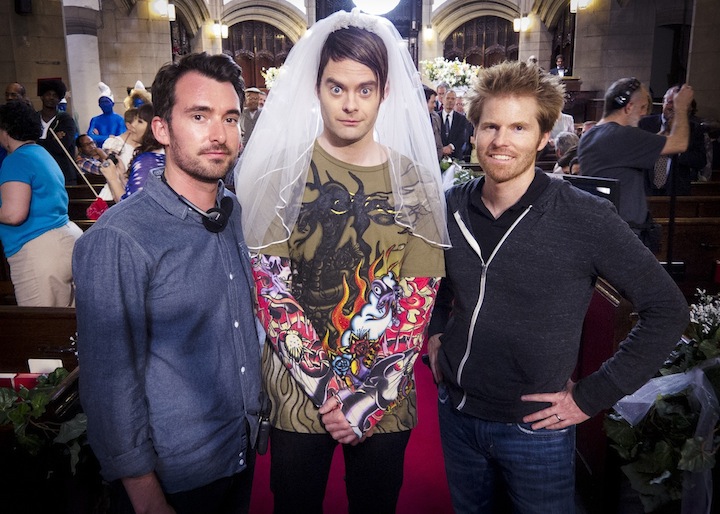
With Director/Producer Rhys Thomas and Bill Hader on the set of “Stefon’s Farewell”
A quick word about the MōVI , for those of you who – I don’t know – have been on vacation in North Korea for the past few months. The MōVI is a 3-axis stabilized camera rig, adopted from the technology that Freefly Systems has spent years developing in the RC Helicopter-Cam biz. The simplest description of the MōVI is a helicopter mount without the helicopter. Granted, that’s quite an oversimplification.
In layman’s terms, the MōVI is a handheld rig that keeps the camera completely stabilized, in some ways like a Steadicam without the arm and vest. Unlike a Steadicam, the MōVI also has a 3-axis head which can be panned, tilted or rolled remotely while it’s being operated – which allows for camera moves that are unlike anything I’ve ever seen and yet are incredibly easy to execute.
The “Stefon’s Farewell” shoot is a perfect example of how the MōVI differs from a traditional moving-camera rig. For the shoot, my director, Rhys Thomas, and I designed a couple of simple running shots that we would normally turn to Steadicam for. We had a profile running shot and a leading / pull-back running shot. Normally we would have hired our go-to Steadicam guy, Phil Martinez, and I know we would have gotten some great shots – Phil is very good! But it’s always a little tricky to figure out how to do a full-speed running shot with the Steadicam, especially a leading shot where the Steadicam operator would have to run backwards. Sometimes the operator can configure the Steadicam so that it’s aiming back over his shoulder shooting behind him while he’s running forward – this is cheekily referred to as “Don Juan” style. Another way to do this kind of shot is to mount the Steadicam and operator on a moving platform. I’ve done moving Steadicam shots off of doorway dollies, golf carts, pickup trucks, even custom-made rickshaws. For the record, these kinds of shots definitely work – the history of cinema is full of incredibly well executed versions of this setup and I’ve certainly done plenty of them , too – but they are a lot of work to coordinate.
For our most complicated shot on the SNL shoot, we wanted the camera to track in low mode with Seth’s feet, sprinting at full speed, and then TILT sharply up to his face. This would be an extremely tricky Steadicam shot. Not only would the rig most likely be mounted to some kind of moving vehicle, but a Steadicam can’t actually tilt up. It can sorta arc-up in a wide swoop but there is no way to perform a sharp tilt-up since the camera is fixed to the Steadicam post. I would also expect this shot to require a handful of takes to coordinate the timing between the actor, the Steadicam operator and the grips who would be driving or pulling the moving platform.
Enter the MōVI. For this shot, Tabb from Freefly operated the MōVI and Mike Hagadorn – also from Freefly — operated the remote control. Tabb simply held the top handle of the MōVI down at arm’s length aimed behind him and ran straight forward, no-looking the shot while Mike kept the camera trained on Seth’s feet and then performed the hard tilt-up to Seth’s face from his remote control. After they nailed the shot on take one, I just stood there with a dumb look on my face: “Uh…I guess we should do it again, right?” So we did another take and they nailed it again. I looked at my watch and realized that at this rate, we could probably shoot half a dozen shots instead of just one or two. So we made up a bunch of other cool shots on the spot and built a nice little sequence out of it – and in a very rare occurrence for any of our SNL shoots – we finished ahead of schedule. Whoa.
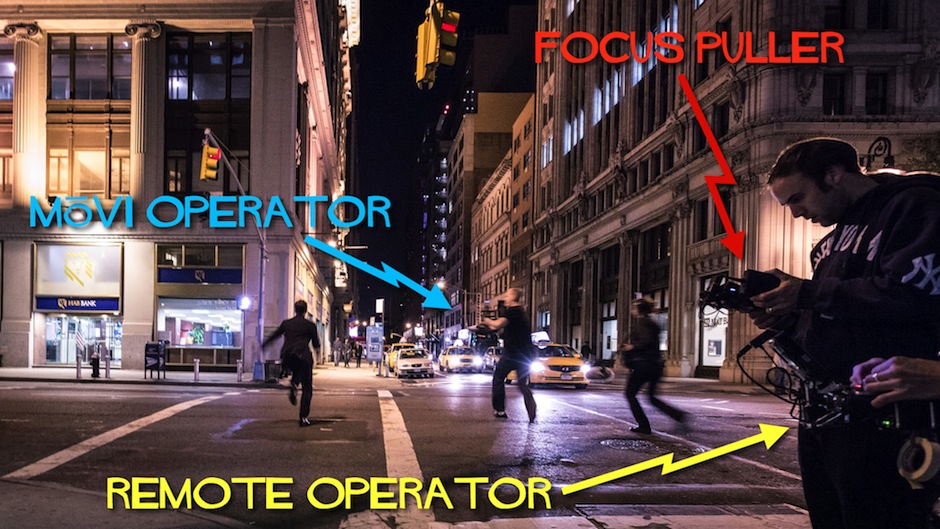
After that jaw-dropping experience, I asked Tabb if he would loan me one of his prototype rigs to bring along on my summer workshop tour and give our attendees a chance to get their hands on it in person. Tabb was game but he and his partners at Freefly – to their credit – requested that I visit them at their offices in Seattle for a full day of training before sending me on the road with one of the original (pre-release) prototype units. So the week before my tour began, I made the trek to Redmond, Washington to spend the day with Tabb and his media manager, Sam Nuttman. Sam walked me through the entire rig, showed me the basic techniques for balancing a camera and the more advanced software interface – which I didn’t even know existed. The full day gave me a much better understanding of what this rig really is, who this rig is for, and how relatively realistic it is for the average shooter to expect to buy one of these and figure out how to use it.
Let’s start with what this rig really is. I assumed – like many of you, I bet – that the MōVI is a feat of mechanical engineering, like a Steadicam. A Steadicam is all about the perfect distribution of weight between the top and bottom of the sled, and perfect balance at the gimbal point. It’s a miracle of physics and ultimately requires nothing electrical to make it work; the only reason it needs power is for the camera and monitor. There is nothing electronic about the way it is stabilized.
The MōVI, on the other hand, is a combination of mechanical engineering and electronic wizardry. Without venturing beyond my depth here, the MōVI has three silent gyro-motors that are being fed instructions by a central Motor Driver. The Motor Driver is getting information from another little box mounted under the camera called the IMU (Inertial Measurement Unit), which is where the real stabilizing magic happens. Working together, the IMU, Driver and Motors keep the camera locked on the horizon without the drift you sometimes see in other stabilized-rig shots. Because of this electronic aspect to the rig, the door is open for a software interface, which Freefly has developed and is offering as an Android app (and hopefully someday as an iOS app). The software allows you to connect to the rig via Bluetooth and fine-tune the balance / tweak the motors remotely. This is especially useful when in single-person mode, or “Majestic” mode as they call it. When you’re operating in Majestic mode, you steer the rig with the handlebars. You become conscious very quickly of the amount of “turn” you have to apply to make the rig turn. Freefly calls this the “steering window” – and this window can be modified through the software interface. A wide window means you need to turn the handlebars more before the camera will turn in that direction. A tight window means the camera is much more responsive to steering – which can be good or bad depending on the shot. A wide window seems to me much smoother but a tight window is much more precise. The software interface opens the doors to other features too – motion tracking, for instance.
I’ve been on my workshop tour for about 5 weeks now, so I’m operating a MōVI demo every other day – and playing with it on our off days. In my experience so far, the Majestic mode is very cool but what makes this rig so truly innovative is the Dual Mode – where one person operates the rig while another person operates a remote control to pan / tilt the camera independently. The remote control that Freefly sent out with our prototype rig is an off-the-shelf RC controller made by Futaba, which looks like an Xbox controller on the juice. It’s got buttons and switches all over it – most of which are beyond what’s needed for the MōVI. One thing I’ll add about the controller: if you happen to be a gamer, operating this MōVI remote is going to feel very familiar to you. Yes: all those hours playing “Call of Duty” are finally going to pay off.
The important controls are the right joystick, which controls both the pan and tilt, and the two dials above the joystick, which control the speed of the pan and tilt (independently). The left joystick is non-functional in my configuration but it could easily be programmed to control the roll-axis – I just don’t have it setup that way since roll-axis movement seems a little advanced for first-time operators.
The thing to understand is that you can use any controller with the MōVI. Freefly happens to use the Futaba controller because it has enough channels to handle all of the things the MōVI can do (and I imagine also because it’s a traditional RC controller – something they’re used to). But there is nothing special or necessary about the Futaba controller itself — the MōVI just requires a minimum of 6 channels (8 channels is ideal). On that note, I would love to see a MōVI controlled by some kind of modified Hot Gears Remote System.
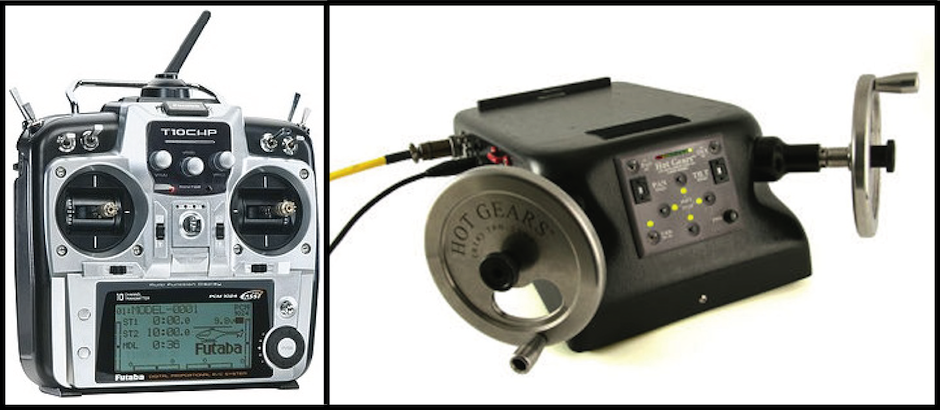
Futaba RC Controller versus a HotGears Remote System
As soon as you start to imagine the MōVI controlled not by a joystick-based RC controller but by a more traditional set of pan/tilt wheels, it starts to dawn on you that the MōVI is not necessarily like a Steadicam at all. In some ways, the MōVI is a lot more like a Technocrane, in that in requires the coordination of two people to get the most out of it. Sure, there will be lots of great MōVI shots in Majestic mode, but the really killer shots are going to be in Dual Mode, where I predict a next generation of Alfonso Cuaron / “Children of Men”-grade continuous action shots that will blow our collective minds.
The MōVI M10 rig – designed for cameras that weigh up to 10 pounds – is the only version of the rig that anyone has yet seen. The Freefly engineers are designing both an M20 rig – for Alexa-sized cameras that weigh up to 20 pounds, and an M5 rig – for DSLR-sized cameras up to 5 pounds. On that note, another interesting difference between the MōVI and a Steadicam is that, while the Steadicam requires a minimum weight to balance, there is no minimum weight limit for the MōVI. You could literally mount it with an iPhone or a cup of coffee for that matter – as long as you balance it.
Both on the SNL shoot and on the tour, we’re using the M10 with a Canon 1DC and Canon 24mm Cine Prime. The only other camera I’ve seen rigged in the MōVI is a Red Epic – which also works well. Theoretically, you could mount any number of other cameras as long as they weigh less than 10 pounds – this rig is just so new, no one has done it yet. Would an Alexa-M work? Would a C500 work? Someone try it and lemme know! The fact that the rig is adjustable enough to accommodate all kinds of different camera configurations is another thing that sets the MōVI apart.
My resident MōVI-tech on the tour, Jeremy Silveira, has the M10 rigged with a Teradek Bolt wireless video transmitter system and a Redrock Micro microRemote wireless focus unit with Redrock’s unique fingerwheel controller. This is an amazing little addition to a wireless follow focus that you can mount to the handheld handles of a camera so that the operator can pull his own focus using his index finger. I’ve never seen anything like this before and it is quite a huge improvement over grabbing the barrel while you’re operating a handheld shot. On the MōVI, it means that in Single-Person Mode, the operator can pull his own focus – which is obviously a huge advantage for the one-man-band operators out there. In truth, I think it’s a lot to ask for an operator to execute a great shot while also pulling focus on the shot – but for some operators, this could be a big selling-point skill.
There’s been a bit of debate about the price of the MoVI. The M10 costs $15,000 – which gets you the rig and the remote control unit. You would need to add a wireless follow focus system, wireless transmitter system and onboard monitor to complete the kit (along with a camera and lens, of course). Naturally there’s been a little grumbling about that price – to which I think there is a little confusion about what this thing really is. No one (I hope) would buy a Steadicam and think they’re going to throw on the vest the next day and pull off a PT Anderson shot. Everyone sorta gets that Steadicam operating is a big deal that requires training and practice – and accordingly, the relatively high price tag of a Steadicam system doesn’t seem inappropriate at all, (which, for the record, is around $65k for the base price of a full-scale Steadicam Ultra2).
To me, the MōVI is not so different and point is, $15k doesn’t seem unreasonable given what this rig is capable of doing. I’ve heard chatter that the MōVI is just like any other RC-helicopter rig; that anyone could build their own “MōVI rig” for a tenth of the price. This guy built a stabilized rig for $500…Right on! I think that’s awesome. There are lower-priced versions of Steadicams and Technocranes, too. Glidecams and Fig-Rigs are great tools for the price, but the truth is, I’m still hiring Steadicam operators when I need a high-end shot executed.
Having said that, Freefly is by no means the inventor of the gyro-stabilized camera head – that concept has been around for decades and lots of companies make them. The unique thing that Freefly has done is create a stabilized head small enough and intuitive enough for a person to easily handhold, without compromising the quality of the stabilization. It was a pretty neat trick on our SNL shoot for Tabb to sprint full speed without even looking at the image and still get a perfectly stable shot. The most astonishing thing about the MōVI – and another departure from a more conventional stabilized-camera rig – is that virtually anyone can operate it — something I’ve experienced first-hand in my workshop, where literally thousands of my attendees have picked up the MoVI and pulled off perfectly stable tracking shots on their first try. Conversely, I can say in all candor that I have no hope of ever developing the deep skillset required to successfully operate a Steadicam.
On that note, there is also a lot of murmuring about how this rig will affect the Steadicam community. In my earlier years as a camera assistant, I worked for Steadicam legends including Robert Presley, Steve Campanelli, Ray Stella and Dave Luckenbach; I’ve humbly met Garrett Brown a few times — the inventor of the Steadicam and the dude responsible for those incredible tracking shots from “The Shining” among so many other of my favorite films. The talent of those operators vastly exceeds the technology of any camera system. current time Far more critically, great Steadicam operators already understand how to design and execute the kinds of shots this thing would be so good for. No one is more qualified than they are when it comes to working with directors and actors to create amazing continuous action shots. The actual Steadicam is just a tool in the kit; the MōVI is another tool. And they’re not mutually exclusive – how about mounting the MoVI onto a Steadicam arm?
On the flip-side, the MōVI M5 is targeted to cost less than $7,500 – something much more reasonable for the DSLR-filmmakers out there – which includes me when I’m making my own independent films! And finally, if you’re expecting to buy a MōVI-type rig for the same price you paid for your flight to NAB this year, I’m sure you’ll find the inevitable Chinese knock-off in the very near future, with usability and performance to match that price.
Ultimately, there’s no question that the MōVI is in the infancy stage of its development. It’s like going back to 1976 when Garrett Brown first climbed those steps of the Philadelphia Art Museum lugging an experimental camera rig for that iconic shot from “Rocky”.
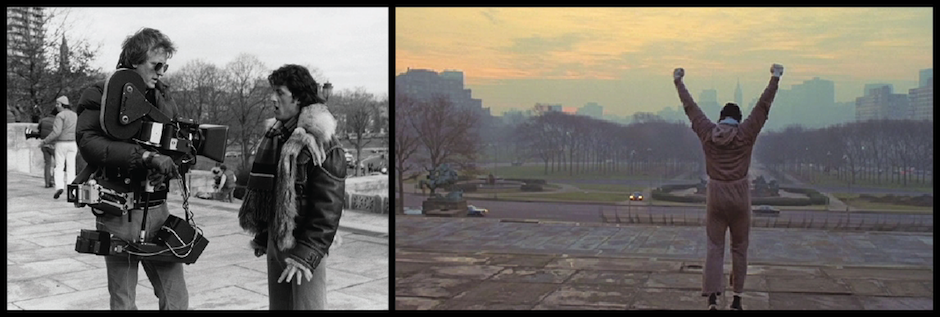
Garrett Brown and Sly Stallone on the set of “Rocky” in 1976.
Not so dissimilar, the MōVI I’m using on my workshop tour is one of the original prototype units and it looks like something out of a Shane Carruth movie – it’s got dangling wires and is patched together in places with electrical tape and lead counterweights. I’ve never seen the “finished” MōVI that so many of you queued up to purchase after that wild NAB debut but I’m sure it will be all buttoned-up and even easier to operate than the one I’ve been playing with for this past month. Even so, I’m completely sold on the concept. There is still a lot to figure out; certainly there will be tweaking to make this rig more production-friendly and there will be applications that no one could have predicted… That’s been one of the fun side-effects of picking this rig up: you suddenly get a rush of ideas for shots that are otherwise so hard to pull off: how about a horseback shot or a high-speed boat sequence? How about chasing someone into a vehicle, passing the rig off and then driving away with it? Ultimately, the possibility for never-before seen shots that are neither Steadicam shots nor Technocrane shots seems practically limitless. What you do with it will only be restrained by your creativity.
If you want get your hands on the MōVI in person as well as see the rest of my workshop, check out the Visual Storytelling Tour. We’ve got 4 more weeks and 16 more cities to go! Baton Rouge: we’ll see you on Sunday!
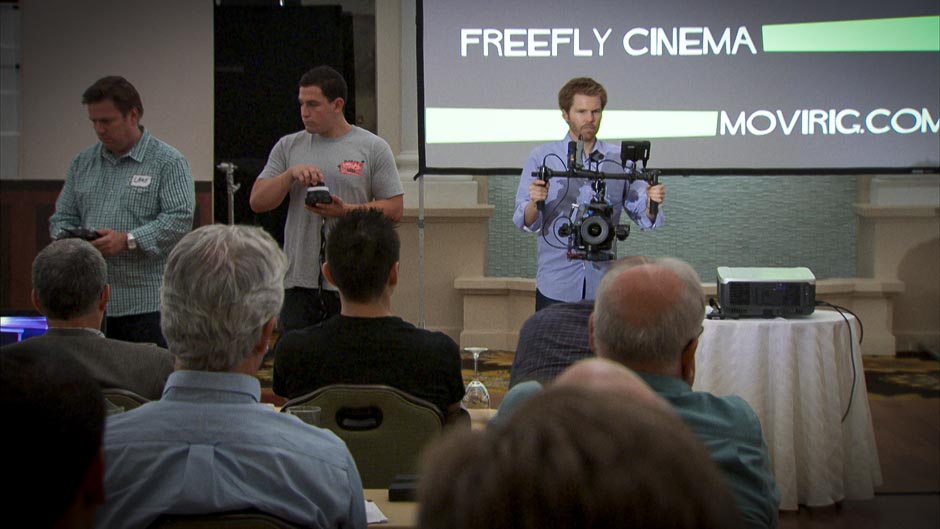
The MōVI demo segment of the Visual Storytelling workshop

